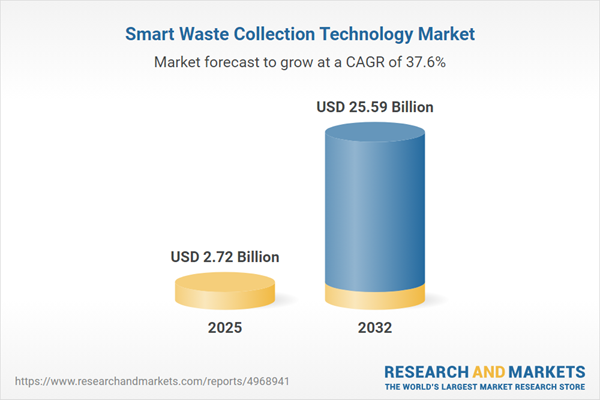Speak directly to the analyst to clarify any post sales queries you may have.
Smart waste collection technology is reshaping enterprise and municipal operations by providing data-driven solutions that optimize efficiency, compliance, and sustainability. Senior decision-makers gain essential tools to streamline waste management while meeting evolving regulatory and environmental expectations.
Market Snapshot: Smart Waste Collection Technology Market Growth
The smart waste collection technology market continues to record steady expansion, driven by digital transformation strategies among enterprises and municipalities. Market value is experiencing consistent growth, reflected by a reliable compound annual growth rate (CAGR) as organizations respond to the surge in waste volumes and heightened sustainability mandates. Regulatory requirements for secure, traceable collection and reporting are further accelerating investment in the sector. Both public and private stakeholders are prioritizing funding for sensor-enabled platforms, automated resource management, and real-time analytics. Adoption of these advanced technologies supports organizations aiming to uphold operational resilience and meet compliance targets in a changing regulatory landscape.
Scope & Segmentation: Smart Waste Collection Technology
This report offers comprehensive insights for procurement executives, technology leaders, and investors navigating the smart waste collection technology market. Analytical coverage includes critical market segments, prevailing technology trends, and region-specific dynamics. Each market aspect is evaluated to clarify growth drivers, obstacles, and competitive priorities.
- Technology: Emphasis on aboveground solutions provides agile installation and versatility for rapidly evolving urban challenges. Underground systems deliver space-efficient, low-visibility alternatives tailored to high-density developments and complex environments.
- Component: Key market components are advanced waste containers, smart sensors for real-time monitoring, robust network communication modules, and centralized control units that enable integrated management and analytics. Supporting solutions such as platform integration services and ongoing maintenance strengthen long-term scalability and reliability.
- Waste Type: Smart collection systems efficiently address hazardous, organic, and recyclable waste streams, ensuring responsive compliance and environmental alignment across diverse operational needs.
- End User: Adoption is tailored to commercial, industrial, residential, and municipal contexts, enabling each sector to achieve specific regulatory, workflow, and sustainability goals.
- Regional Insights: The Americas invest in infrastructure modernization and stricter sustainability standards. EMEA markets adapt through regulatory reform and diverse procurement strategies, while Asia-Pacific leverages advanced digital infrastructure and localized implementation models for increased adoption.
- Industry Participants: Market providers focus on analytics integration, ensuring system interoperability, and technical support services to reduce procurement risk and improve continuity of operations.
Key Takeaways: Strategic Advantages of Smart Waste Collection Technology
- IoT and cloud-based analytics provide real-time visibility across operations, empowering proactive resource management and multi-site oversight.
- Route automation and process digitalization improve collection efficiency, reduce manual workload, and help organizations quickly adapt to evolving compliance requirements.
- Machine learning and artificial intelligence bolster predictive maintenance strategies, leading to greater equipment dependability and less service interruption from unforeseen failures.
- Comprehensive digital compliance platforms simplify auditing and reporting, ensuring transparent responses to new or changing legal frameworks.
- Modular, scalable architectures allow for precise deployment within diverse regulatory and infrastructure settings, enhancing operational flexibility.
Tariff Impact on Supply Chains and Component Costs
Recent changes in U.S. tariff regulations have raised the cost of key smart waste system components, particularly sensors and control modules. In response, organizations are shifting focus to interoperable, software-centric platforms to maintain agility and limit exposure to supply chain disruptions. Expanding and diversifying supplier networks is increasingly important for maintaining consistent service and long-term supply chain stability as policy environments evolve.
Methodology & Data Sources
The report’s findings are based on direct interviews with executives from the enterprise and municipal sectors, targeted procurement surveys, and exclusive information from technology vendors. Independent examination of regulatory trends and subject-matter expert input ensures that insights align with the strategic planning requirements of top-level decision-makers.
Why This Report Matters
- Enables development of technology roadmaps that reflect the current and emerging needs of B2B operations in highly regulated environments.
- Clarifies primary adoption drivers, helping executives anticipate regional regulatory changes and procurement trends.
- Supports the establishment of resilient, adaptable waste management frameworks for organizations navigating varying regulatory and operational scenarios.
Conclusion
Integrating smart waste collection technology positions organizations for consistent, compliant operations while supporting long-term sustainability and efficiency goals. As regulatory and market demands evolve, data-centric solutions will be vital for maintaining future readiness and operational resilience.
Additional Product Information:
- Purchase of this report includes 1 year online access with quarterly updates.
- This report can be updated on request. Please contact our Customer Experience team using the Ask a Question widget on our website.
Table of Contents
3. Executive Summary
4. Market Overview
7. Cumulative Impact of Artificial Intelligence 2025
Companies Mentioned
The companies profiled in this Smart Waste Collection Technology market report include:- International Business Machines Corporation
- Cisco Systems, Inc.
- Oracle Corporation
- Schneider Electric SE
- Bigbelly, Inc.
- Enevo, Inc.
- Ecube Labs Co., Ltd.
- Compology, Inc.
- Sensoneo, s.r.o.
- Rubicon Technologies, LLC
Table Information
| Report Attribute | Details |
|---|---|
| No. of Pages | 192 |
| Published | October 2025 |
| Forecast Period | 2025 - 2032 |
| Estimated Market Value ( USD | $ 2.72 Billion |
| Forecasted Market Value ( USD | $ 25.59 Billion |
| Compound Annual Growth Rate | 37.6% |
| Regions Covered | Global |
| No. of Companies Mentioned | 11 |









